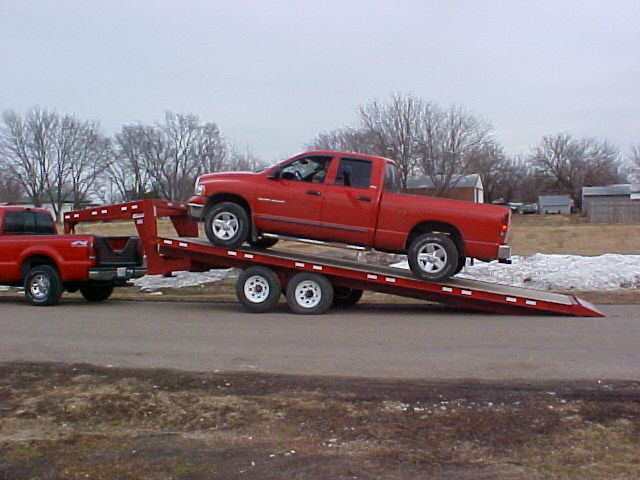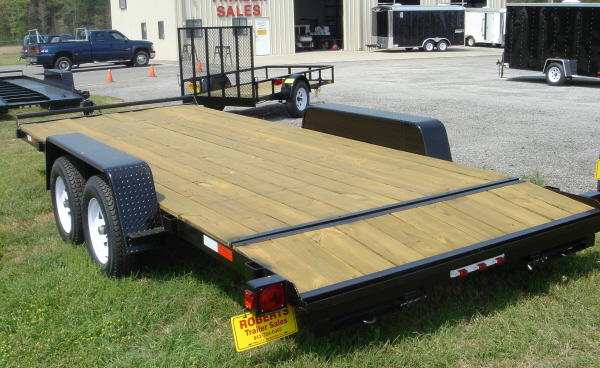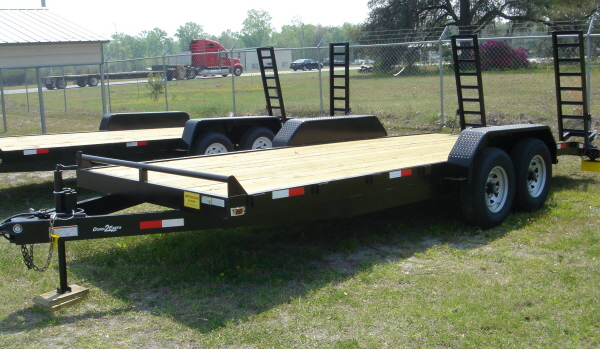How to install the app on iOS
Follow along with the video below to see how to install our site as a web app on your home screen.
Note: This feature may not be available in some browsers.
You are using an out of date browser. It may not display this or other websites correctly.
You should upgrade or use an alternative browser.
You should upgrade or use an alternative browser.
Guess these equipment trailer weights !
- Thread starter Milacron
- Start date
- Replies 38
- Views 10,839
mulesandheelers
Aluminum
- Joined
- Feb 14, 2006
- Location
- N.E. Oregon
A. 1,750
B. 2,100
B. 2,100
I hope you guys are right. The owner of the trailer store looked up "A" and told me it was "just over 2,000 lbs" so that's why I went with the 2,000 lb guestimate (I didn't ask the weight of B), but really ~1,700 lbs makes more sense to me too, esp considering the price.
It is beyond comprehenson how anyone in Georgia makes these things at those prices and somehow makes a profit..esp considering those are retail prices, not the wholesale the trailer maker actually gets....not to mention freight to the retailer.
Now you're of course wondering why the hell I'm looking at trailers aren't you ?

It is beyond comprehenson how anyone in Georgia makes these things at those prices and somehow makes a profit..esp considering those are retail prices, not the wholesale the trailer maker actually gets....not to mention freight to the retailer.
Now you're of course wondering why the hell I'm looking at trailers aren't you ?

mulesandheelers
Aluminum
- Joined
- Feb 14, 2006
- Location
- N.E. Oregon
"Now you're of course wondering why the hell I'm looking at trailers aren't you ?"
--------------------------------------------------------------------------------
Not until you mentioned it, just figured it was a slow day.
--------------------------------------------------------------------------------
Not until you mentioned it, just figured it was a slow day.
Cause you finally got busted pulling that big one around?!?Now you're of course wondering why the hell I'm looking at trailers aren't you ?

matt_isserstedt
Diamond
- Joined
- Dec 15, 2003
- Location
- suburbs of Ann Arbor, MI, USA
Don, I have looked half seriously at the Kaufman version of the 2nd one, 2 x 7000lb axles, 14k GVW, 2-5/16" ball and full-forged 1pc drawbar. Radial tires. Electric brakes both axles.
Course more expensive than either of these.
You might as well give up why you are looking
I think there's a lot of competition for trailers, so maybe that holds the price down. Not sure where all the old ones go.
One question (unrelated) I've been mulling over is the difference between a 14k bumper-pull as above and a 14k single-tire gooseneck.
The gooseneck typically built with 10" I-beams, the bumper pull "equipment" version built with 6" channel. Not sure if that is something to worry about or not, or just trust the manufacturer's GVW rating, and be more sensitive with tongue loads on the bumper-pull version.
(bumper-pull being a colloquial term for receiver-hitch...kinda like "cherry picker" )
)
Course more expensive than either of these.
You might as well give up why you are looking

I think there's a lot of competition for trailers, so maybe that holds the price down. Not sure where all the old ones go.

One question (unrelated) I've been mulling over is the difference between a 14k bumper-pull as above and a 14k single-tire gooseneck.
The gooseneck typically built with 10" I-beams, the bumper pull "equipment" version built with 6" channel. Not sure if that is something to worry about or not, or just trust the manufacturer's GVW rating, and be more sensitive with tongue loads on the bumper-pull version.
(bumper-pull being a colloquial term for receiver-hitch...kinda like "cherry picker"
 )
)Yep, the A trailer is used tires, but I think B has new tires. More important to me is to check for radial vs conventional cord..which I forgot to do.Check the tires, most have used tires.
LOL ! Nah, just thinking about getting a smaller one (read- much lighter and less wind resistance) for longer trips to pick up iron less than say 6,000 lbs or so...better fuel mileage (more important now that diesel has gone insane), and less worries about getting busted going into the 'fretful' states far beyond the borders of friendly little SC.Cause you finally got busted pulling that big one around?!?
Dave A
Titanium
- Joined
- Jan 4, 2005
- Location
- Roseville, CA
Sounds like trailer B would be a good choice, as able to haul most machines, or two to three smaller ones. Just curious how much bracing is under that wood deck. Does the rest of the trailer frame fit with the axle capacity?
matt_isserstedt
Diamond
- Joined
- Dec 15, 2003
- Location
- suburbs of Ann Arbor, MI, USA
The main reasons why the bumper-pull 14k trailer was attractive are:
- absolutely no concerns with motor carrier enforcement...you "blend in" with the other knuckleheads on the road towing skid loaders, etc.
- I could probably hide, keep, and store a bumper-pull trailer much more easily than a gooseneck.
The one I borrowed from a friend has a 4k forklift on it (guessing 8k total weight)...can't even tell a load is there from looking at the tires.

- absolutely no concerns with motor carrier enforcement...you "blend in" with the other knuckleheads on the road towing skid loaders, etc.
- I could probably hide, keep, and store a bumper-pull trailer much more easily than a gooseneck.
The one I borrowed from a friend has a 4k forklift on it (guessing 8k total weight)...can't even tell a load is there from looking at the tires.
Grits
Stainless
- Joined
- Dec 14, 2004
- Location
- Little Rock, Arkansaw
My guess is less than what you think. We have gone through many similar trailers on the farm. They are very easy to steal. We always make sure the load rating on the tires is => the load rating of the trailer. That is not always the case.
Grits
Grits
Matt, were you able to drive that blue thing up the trailer ramps ok, or did it get placed by some other means ? Just wondering if a small cushion tire forklift can go up open grid ramps like that and if there are "bottoming out" issues due to low clearance on the forklift, to consider.
matt_isserstedt
Diamond
- Joined
- Dec 15, 2003
- Location
- suburbs of Ann Arbor, MI, USA
Don, I used 2x6s on both ramps for the "blue thing"  . No issues of wood breakage or real problems with slippage either.
. No issues of wood breakage or real problems with slippage either.
My main concern was bottoming out the frame rails as I crested the "dovetail" to the trailer flat but it went right over with nary a scrape.
So...an interesting question to be raised is about the overall ramp angle of the "lowboy" trailer (deck slightly higher than axle centerline) vs. the same angle on the higher "twin dual" trailer where the wheels are completely under the trailer, the deck correspondingly higher, and the tail longer by some more too.
Adding: I'd be interested to try this with my little orange 3K in the avatar, it has a slightly shorter wheelbase. However, I figure that any scraping could be fixed with something as simple as a 3/4" piece of hardwood flooring placed on the 2x6, ahead of the rear/steer tires just as the frame starts to scrape, causing a slight lift for a couple inches.
 . No issues of wood breakage or real problems with slippage either.
. No issues of wood breakage or real problems with slippage either.My main concern was bottoming out the frame rails as I crested the "dovetail" to the trailer flat but it went right over with nary a scrape.

So...an interesting question to be raised is about the overall ramp angle of the "lowboy" trailer (deck slightly higher than axle centerline) vs. the same angle on the higher "twin dual" trailer where the wheels are completely under the trailer, the deck correspondingly higher, and the tail longer by some more too.
Adding: I'd be interested to try this with my little orange 3K in the avatar, it has a slightly shorter wheelbase. However, I figure that any scraping could be fixed with something as simple as a 3/4" piece of hardwood flooring placed on the 2x6, ahead of the rear/steer tires just as the frame starts to scrape, causing a slight lift for a couple inches.
matt_isserstedt
Diamond
- Joined
- Dec 15, 2003
- Location
- suburbs of Ann Arbor, MI, USA
Main disadvantage I see with the lowboy/bumper-pull is that it would be somewhat tough to load the trailer from the side, over the fenders. I don't think a pallet could be set there without a lot of pushing or pulling. And, as that's the prime area for a heavy load...over the axles, one would have to use the forks as overhead lifting devices with a sling or such.
With the "twin dual" setup you have instant deck on all sides, and a heavy load close to the mast can at least be set on the deck. Pallets much easier also, without a bunch of overhead rigging.
Short-wheelbase, single-tire/dual axle gooseneck anyone???
With the "twin dual" setup you have instant deck on all sides, and a heavy load close to the mast can at least be set on the deck. Pallets much easier also, without a bunch of overhead rigging.
Short-wheelbase, single-tire/dual axle gooseneck anyone???

Yep, and also difficult to tie down machines sometimes because they happen to be situated between the fenders. On previous bumper pull trailers I mounted forged eye bolts in the trailer floor in the fender areas for this reason.Main disadvantage I see with the lowboy/bumper-pull is that it would be somewhat tough to load the trailer from the side, over the fenders
A Bridgeport mill, loaded by forklift, is the ideal "deck under" trailer situation, since it can be loaded from the side due to being one of the few machines that tend to be picked up in a place other than the bottom of the machine. Of course even then, often one will be cussing about the fenders getting in the way unless the forklift has extra long forks. The beauty of deck over loading is even if forks not long enough you just set machine down on edge anywhere on the trailer and then push it to center.
So, the "deck over" trailers like my gooseneck are definitely better for serious hauling, but the low center of gravity and light weight of these bumper pull types do have their appeal for certain hauling jobs.
But getting back to goosenecks, here's a couple for you to ruminate over...
Low and sleek deck under..

A rollback deck over trailer !

Have a cup of coffee, and re read....why would you think the axle capacities arent what they told you.??? Doug
posted 04-07-2006 09:23 PM
--------------------------------------------------------------------------------
Exhibit A is 18 foot with two 3,500 lb axles, slide in ramps $1,700
Exhibit B is 20 footer with two 6,000 lb axles, folding ramps $2,500
I guess 2,000 lbs on A and 3,000 lbs on B. What do you guess ?
Are you not questioning the axle weights ??
--------------------------------------------------------------------------------
Exhibit A is 18 foot with two 3,500 lb axles, slide in ramps $1,700
Exhibit B is 20 footer with two 6,000 lb axles, folding ramps $2,500
I guess 2,000 lbs on A and 3,000 lbs on B. What do you guess ?
Are you not questioning the axle weights ??
Similar threads
- Replies
- 68
- Views
- 7K
- Replies
- 4
- Views
- 616
- Replies
- 27
- Views
- 4K



